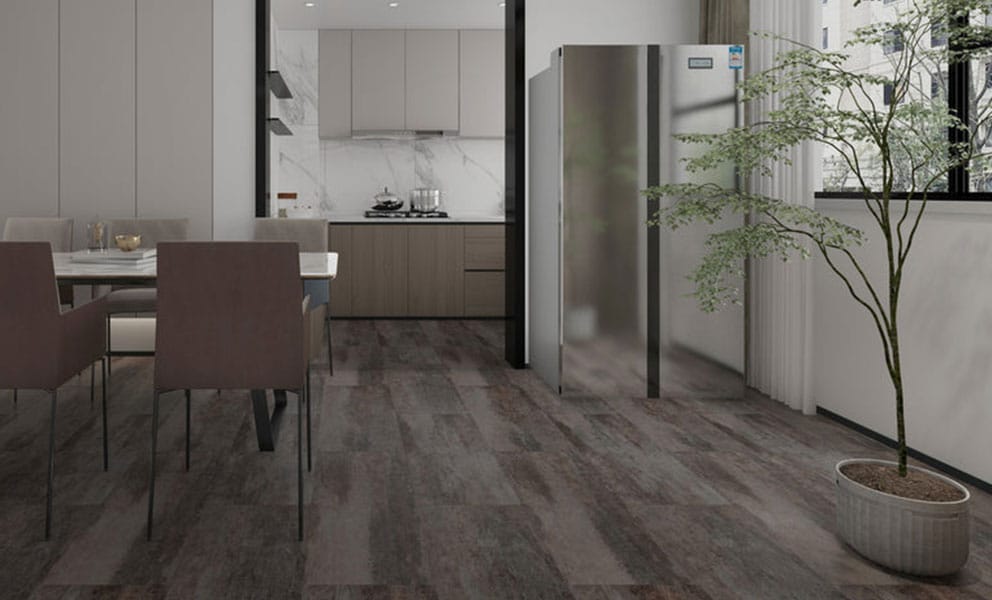Menu

There are several types of vinyl flooring to choose from, each with its own set of benefits. But which is right for your property? Let’s take a look through the key types now...
Luxury vinyl tile (LVT) is a type of vinyl flooring designed to resemble tile, including stone or ceramic. Made from layers of PVC and other materials, LVT flooring is non-porous and very durable.
If you’d like to install some stylish tiles on a budget, luxury vinyl tile makes a perfect alternative. Luxury vinyl tile is much easier to install than ceramic tiles, cutting down on installation costs. It’s also incredibly easy to clean and can be laid on top of existing flooring – eliminating the need to tear out old flooring before installation.
Shaped like planks of wood, luxury vinyl planks (LVP) are designed to look just like wooden floors. Like LVTs, their composition features PVC to establish extra durability. Plus, unlike linoleum flooring, which has its design embedded throughout the materials, luxury vinyl planks feature a specific design layer, broadening the design and texture options.
LVP and LVT both feature extra layers to protect their surfaces from scratches and stains too.
The other option is sheet vinyl. A popular option for many homes, sheet vinyl is known as a waterproof, budget-friendly alternative to wood or tile floors. However, it comes with some downsides.
Sheet vinyl is not as durable and robust as luxury vinyl tile or luxury vinyl planks, meaning that it can scratch and tear much more easily. As it comes in sheets, it’s also a less convincing alternative in comparison to tiles or planks. You’ll also need to ensure the sheet vinyl flooring is installed carefully to ensure the seams are not visible.
If you have a particular room in mind, you’ll want to make sure your flooring fits with its overall style. Fortunately, there is a myriad of vinyl flooring styles available to complement every room.
One of the most popular types of vinyl flooring, wood effect floors are versatile, suiting many different rooms and styles. From the dining room to hallways and the living room, wood effect flooring adds an authentic and stylish look to any room. There are many different varieties to choose from, including vintage oak for an earthy, warm effect, or antique white ash for a neutral, contemporary look.
Wood effect vinyl flooring comes in the form of luxury vinyl planks, which give it an instantly authentic look. Plus, as vinyl flooring is waterproof, it’s even more reliable than real wooden flooring – making it a perfect choice for kitchens or bathrooms.
From contemporary black slate to luxurious marble, stone effect vinyl flooring makes a stunning statement in kitchens and bathrooms. Long lasting and durable, vinyl flooring features all the benefits of authentic stone floors – and some added extras too.
Whilst real stone floors need grouting and sealing to be used, vinyl flooring is naturally waterproof right from the start. It’s also far easier to clean and maintain than stone flooring – and if you’re ready for a change, it’s considerably easier to remove than stone tiles.
Ceramic tiles have much the same issues as stone, requiring a labour-intensive installation that can quickly become expensive. Plus, whilst ceramic tiles are generally long lasting, they usually suffer from a few chips and scratches through the years, which can make them look considerably less visually appealing.
Meanwhile, ceramic effect vinyl flooring is quick and easy to install, saving you time and money. It also features a protective layer to shield your flooring from scratches and tears – and you’ll also find it’s much warmer on your toes after a shower or bath.
Another important factor to consider when weighing up the types of vinyl flooring is the installation type. These generally fall into two categories.
As it sounds, this type of vinyl flooring requires an adhesive to adhere it to the subflooring. This can fall into two varieties – self-adhesive and glue down.
Self-adhesive has an adhesive on the back of the vinyl, which is then attached to the subflooring by placing pressure on the top layer of the vinyl. Glue down vinyl takes the opposite approach, with specialist vinyl glue being applied to the subflooring first and the vinyl fixed on afterwards.
As it uses an adhesive, this type of vinyl flooring will take between one to two days to fully cure. It should also be installed by a professional, which can add to the installation costs. Adhesive vinyl flooring is also not suitable for use in areas with high-moisture subflooring, but it makes a good choice for areas with heavy footfall.
Floating flooring involves minimal to no adhesives to fix the vinyl flooring to the subfloor. Instead, it utilises one of two different techniques – loose-lay or click flooring.
Loose-lay involves gluing the vinyl planks or tiles around the edges of the room to the subfloor, whilst allowing the other planks/tiles to ‘lay loosely’ on the floor without adhesive. Meanwhile, click flooring includes interlocking planks which secure together with a tongue and groove system.
This type of flooring is quick and easy to install, making it a perfect choice for DIYers who want to cut down their costs. Floating vinyl flooring is also easy to replace, without any nasty adhesive to affect your subfloors. It’s also a perfect choice for any subflooring with excessive moisture.
At Igloo Surfaces, we provide high-quality, easy-to-install vinyl flooring that stands the test of time. From Vintage Oak to stylish slate, you’ll find the perfect vinyl flooring to add a striking statement to your rooms.
Featuring a tongue and groove click system, our Simplex range of vinyl flooring is simple to install, with no adhesive required – and there’s a 10-year guarantee for added piece of mind.
Still not sure which type of vinyl flooring is right for your home? Get in touch with our helpful team today.